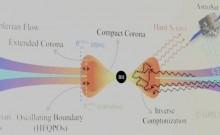NASA's Cassini spacecraft has discovered 'persistent objects' in Saturn's F-ring.
Also Read: NASA looks to solve mystery behind the presence of dark matter in massive M31 galaxy
Cassini spotted two such objects in 2017 while sweeping Saturn's higher atmospheric reaches.
The two objects, F16QA and F16QB, were discovered by Cassini on February 5, 2017. The researchers found that these celestial bodies occasionally bore through the F-ring resulting in "collisional structures".
The phenomenon was also observed in 2006 and 2007 with respect to the object S/2004 S 6.
"While these objects may be mostly loose agglomerations of tiny ring particles, scientists suspect that small, fairly solid bodies lurk within each object, given that they have survived several collisions with the ring since their discovery," a NASA statement said.
"The faint retinue of dust around them is likely the result of the most recent collision each underwent before these images were obtained," the statement added.
According to researchers, these objects organise into loose clusters in Saturn's F-ring under the gravitational influence of the moon, Prometheus. It's more like survival of fittest in space; the clusters that can withstand repeated collisions over time tend to develop orbits of their own.

On February 5, 2017, Cassini's narrow-angle camera captured the photos from Saturn's F-ring, from a distance of 982,000 kilometres (610,000 miles) -- the image at the left -- and 894,000 kilometres (556,000 miles) -- the image on the right-- with six kilometres (four miles) per pixel as the image scale.
The Cassini mission, a joint project between NASA, European Space Agency (ESA) and the Italian Space Agency, was launched in 1997.

















